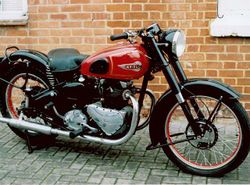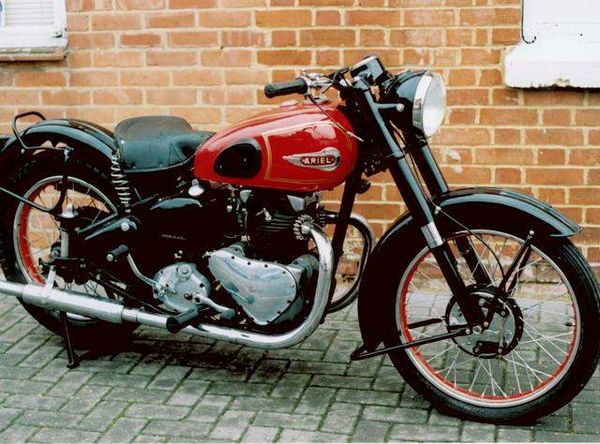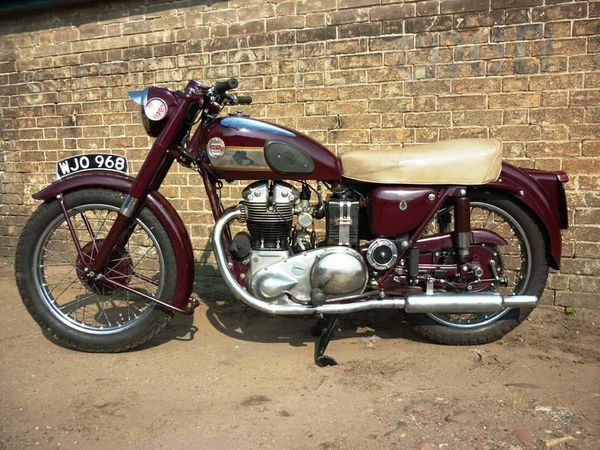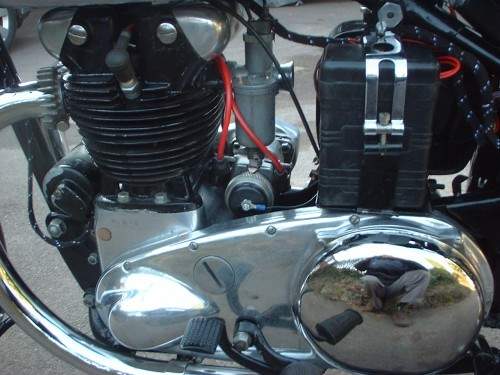Ariel KH500 Fieldmaster
 |
|
| Ariel Fieldmaster | |
| Manufacturer | |
|---|---|
| Also called | KH500 Fieldmaster, KH 500 Fieldmaster |
| Production | 1948 - 57 |
| Engine | Four stroke, stroke, twin |
| Compression ratio | 7.5:1 |
| Top Speed | 145 km/h / 90 mph |
| Transmission | Bruman 4-speed |
| Frame | Duplex loop |
| Suspension | Front: Telescopic forks Rear: Rigid, spring loaded saddle (as from 1957: swinging arm) |
| Wheelbase | 1422 mm / 56 in |
| Weight | 177 kg / 390 lbs (dry), |
| Fuel Capacity | 17 L / 4.5 US gal |
| Manuals | Service Manual |
It could reach a top speed of 145 km/h / 90 mph.
Engine[edit | edit source]
The engine was a Air cooled cooled Four stroke, stroke, twin. The engine featured a 7.5:1 compression ratio.
Drive[edit | edit source]
Power was moderated via the Dry clutch.
Chassis[edit | edit source]
The front suspension was a Telescopic forks while the rear was equipped with a Rigid, spring loaded saddle (as from 1957: swinging arm). The KH500 Fieldmaster was fitted with a 17 L / 4.5 US gal fuel tank. The bike weighed just 177 kg / 390 lbs. The wheelbase was 1422 mm / 56 in long.
Photos[edit | edit source]
Overview[edit | edit source]
Ariel KH 500 Fieldmaster
Designed by Val Page, Ariels KH 500cc twin was produced between 1948 and 1957; starting out as the Red Hunter, becoming the Huntmaster and then the Fieldmaster (surely a name more appropriate for a tractor?), these revisions reflecting its change in role from sportster to tourer. At the time of its launch Ariels new twin seemed to have a bright future. With a top speed of around 90mph, the KH was as fast as a BSA A7 or Triumph Speed Twin, and a real eye-catcher with its red-and-chrome petrol tank. Judged solely on its looks, the Ariel should have been a winner. However, with no competition pedigree and an image that swiftly became one of stolid rustic dependability, its no wonder the relatively expensive Ariel was never a top seller.
Although Pages design was similar in layout to that of Edward Turners Triumph Speed Twin, using the same 63x80mm bore/stroke dimensions, it differed greatly in detail, particularly at the bottom-end where Page opted for a one-piece forging with bolt-on central flywheel rather than a built-up crankshaft. Like Triumph, the Ariel employed separate camshafts but with the pushrods at the four corners of the barrel, enabling cooling air to flow unobstructed between the cylinders. The transmission featured Ariels familiar dry clutch and Burman gearbox. A rigid frame was standard, with Ariels Anstey-designed rear suspension an option, while the design of the tele-forks was shared with parent company, BSA. In 1954 the KH came in for substantial revision, adopting the alloy cylinder head of the short-lived KHA model and a duplex-loop swinging-arm frame. Two years later the single-sided hubs were superseded by Ariels handsome full-width alloy ones and the KH continued in this form until the end of 1957 when the model was dropped. Its demise marked the end of the line for the true Ariel twin, although the BSA-clone Huntmaster continued until 1959.
| Make Model | Ariel KH 500 Fieldmaster |
|---|---|
| Year | 1948 - 57 |
| Engine Type | Four stroke, stroke, twin |
| Displacement | 498 cc / 30.4 cu in |
| Bore X Stroke | 56 x 86 mm |
| Cooling System | Air cooled |
| Compression | 7.5:1 |
| Lubrication | Dry sump |
| Exhaust | 2-into-2, Chrome |
| Induction | Carburetor |
| Starting | Kick |
| Max Power | 20.9 kW / 28 hp @ 6500 rpm |
| Clutch | Dry clutch |
| Transmission | Bruman 4-speed |
| Final Drive | Chain |
| Frame | Duplex loop |
| Front Suspension | Telescopic forks |
| Rear Suspension | Rigid, spring loaded saddle (as from 1957: swinging arm) |
| Wheels | Steel, laced wire spokes |
| Front Rim | 3.00 x 20 |
| Rear Rim | 3.50 x 19 |
| Wheelbase | 1422 mm / 56 in |
| Dry Weight | 177 kg / 390 lbs |
| Fuel Capacity | 17 L / 4.5 US gal |
| Top Speed | 145 km/h / 90 mph |
| Colours | Chrome and scarlet enamel |
| Source | Bonhams |


